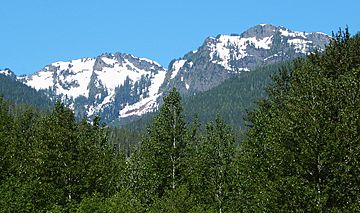Helen Buttes facts for kids
Quick facts for kids Helen Buttes |
|
|---|---|

Helen Buttes seen from North Cascades Highway
|
|
| Highest point | |
| Elevation | 5,560 ft (1,690 m) |
| Prominence | 2,040 ft (620 m) |
| Geography | |
| Location | Skagit County, Washington, U.S. |
| Parent range | Cascade Range |
| Topo map | USGS Marblemount |
| Climbing | |
| Easiest route | Scrambling |
Helen Buttes are two tall mountain peaks. They are located in Skagit County, in Washington state. These peaks are near the western edge of the North Cascades mountain range.
You can find Helen Buttes about four miles northwest of Marblemount, Washington. They are part of the Noisy-Diobsud Wilderness. The land around them is managed by the Mount Baker-Snoqualmie National Forest. The closest peak that is taller than Helen Buttes is Diobsud Buttes, which is about 3.11 miles (5.01 km) to the north. Water from rain and melting snow on Helen Buttes flows into streams that eventually reach the Skagit River.
Weather at Helen Buttes
Helen Buttes is in a marine west coast climate zone. This means it has a wet and mild climate. Most of the weather systems come from the Pacific Ocean. They travel northeast towards the Cascade Mountains.
As these weather systems reach the North Cascades, the mountains force the air to rise. This causes the air to cool and drop its moisture. This moisture falls as rain or snow on the mountains. This process is called Orographic lift. Because of this, the western side of the North Cascades gets a lot of rain and snow. This is especially true during the winter months.
The climate here is mild because it's close to the Pacific Ocean. Temperatures rarely go below 0 °F (−18 °C) in winter. They also rarely go above 80 °F (27 °C) in summer. Winters are usually cloudy. But in summer, high pressure systems over the Pacific Ocean often bring clear skies. The snow here tends to be wet and heavy. This can make avalanches more likely.
How the Mountains Formed
The North Cascades mountains have very rugged shapes. You can see jagged peaks, long ridges, and deep valleys carved by glaciers. These different shapes and big changes in height were created by geological events over millions of years. These events also led to the different climates and types of plants found in this area.
The Cascade Range started forming millions of years ago. This was during the late Eocene Epoch. At that time, the North American Plate was slowly moving over the Pacific Plate. This movement caused many volcanic eruptions. Also, small pieces of the Earth's crust, called terranes, joined together. This helped create the North Cascades about 50 million years ago.
During the Pleistocene period, which was over two million years ago, large glaciers repeatedly moved across the land. As they moved, they scraped and shaped the landscape. They left behind piles of rock and debris. The river valleys in this area have a "U" shape. This shape was created by these recent glaciers. The rising of the land (called uplift) and faults, along with the action of glaciers, have created the tall peaks and deep valleys of the North Cascades.



